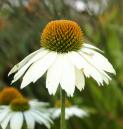 The dried leaves of Eucalyp'tus glob'ulus Labillardierre, collected from the older parts of the tree with not more than 3 per cent. of the stems and fruit of the tree or other foreign matter.
The dried leaves of Eucalyp'tus glob'ulus Labillardierre, collected from the older parts of the tree with not more than 3 per cent. of the stems and fruit of the tree or other foreign matter.
BOTANICAL CHARACTERISTICS.—Rapid-growing trees, attaining the height Of 200 to 300 feet. Flowers solitary, or in clusters of 2 or 3, axillary; peduncles broad, somewhat hemispherical in shape, prolonged into a cone, and united with the petals and 4- or 5-celled ovary, making a peculiar hard, brittle, floral envelope, which is quite aromatic. Wood exceedingly hard, remarkable for toughness and durability.
SOURCE.—This is an Australian tree, but is cultivated extensively, especially in malarial districts in various subtropical portions of the world. In California the tree is abundant. At the State Forestry Station at San Monica forty-four species are cultivated. Among these, the Globulus is the most valuable. The Amygdalina possesses the best emollient properties. E. rostrata Schlecht (red gum) furnishes an inspissated juice, which is used for the same purpose as kino.
It has been stated that the anti-malarial property attributed to these trees is probably due to their power of absorbing moisture rather than from emanations from them. They probably act in a dual capacity.
DESCRIPTION OF DRUG.—Petiolate, scythe-shaped, from 150 to 300 mm. (6 to 12 in.) long, 20 to 40 mm. (⅘ to 1 ⅗ in.) broad, tapering from near the base to the apex; pale grayish-green, smooth, and of a leathery texture; margin entire, with a parallel vein a short distance from it, running from base to apex of the leaf; odor camphoraceous; taste cooling, bitter, astringent, and aromatic.
Powder.—Characteristic elements: See Part iv, Chap. I, B.
CONSTITUENTS.—The virtues of the leaves depend upon a volatile oil (which contains the valuable antiseptic, Eucalyptol) existing to the extent of 2 to 6 per cent.; the freshly-dried leaves yield the greatest proportion.
ACTION AND USES.—Used as a febrifuge, stimulant, and astringent. Its principal action, however, is that of the volatile oil, or rather its chief constituent, eucalyptol, C10H18O, antiseptic. Dose: ½ to 2 dr. (2 to 8 Gm.). Dose of eucalyptol cineol: 5 drops (0.3 mil)
OFFICIAL PREPARATION.
- Fluidextractum Eucalypti Dose: 5 to 60 drops (0.3 to 4 mils).
368a. OLEUM EUCALYPTI.—A colorless or yellowish volatile oil, distilled from the fresh leaves. It has a spicy, cooling taste, and somewhat camphoraceous odor. Consists of two hydrocarbons (cymene, C10H14, and eucalyptene, C10H16), a terpene, and Eucalyptol, C10H18O, upon which its value depends; it is obtained as one of the fractions in the distillation of the oil, coming over between 170° to 178°C. It should contain not less than 70 per cent. of Eucalyptol when assayed by the official process. Should be kept protected from light in cool place. It is a nearly colorless liquid, with a strong, aromatic, camphoraceous odor; slightly soluble in water, but very soluble in alcohol, carbon disulphide, and glacial acetic acid. Dose: 5 to 10 drops (0.3 to 0.6 mil). Antiseptic. Used frequently as an inhalant in respiratory diseases either with atomizer or with steam. Dose of the oil: 5 to 10 drops (0.3 to 1 Mil).
368b. EUCALYPTUS ROSTRATA Schlecht.—RED GUM. The resin or inspissated juice. Synonyms: CREEK GUM, MURRAY RED GUM, RED GUM KINO, EUCALYPTI GUMMI. Habitat: Australia. Small, angular, ruby-red, shining pieces; in thin layers transparent. Resembles kino, but has a brighter appearance and is less astringent. The taste is bitter. Almost entirely dissolved by alcohol. Properties: A good astringent, similar to kino. Preparations: Fluid and lozenges. Uses: Checks the purging of mercurial pills administered for syphilis. Has been recommended for seasickness. Dose: 5 to 20 Minims of the fluid.

